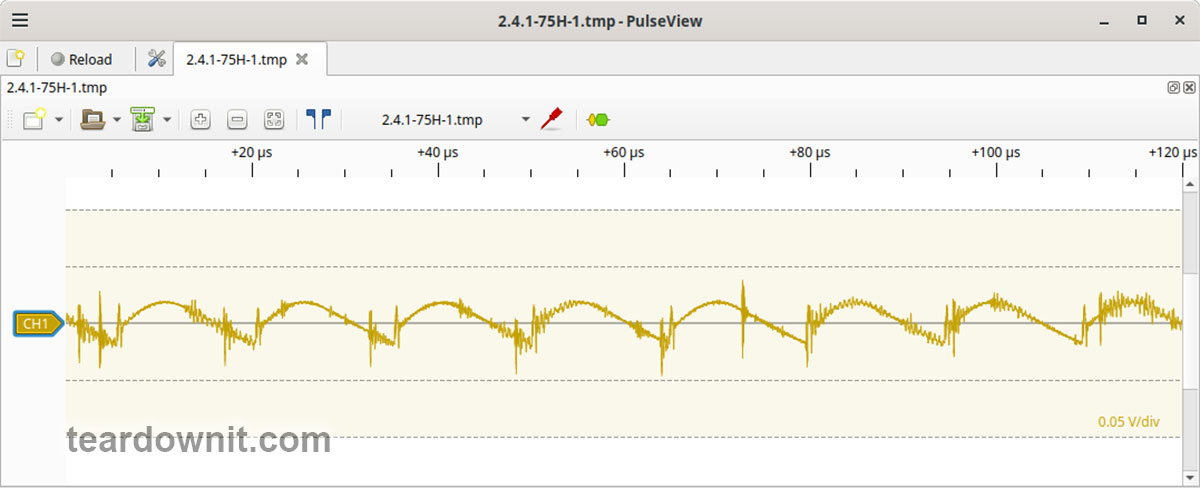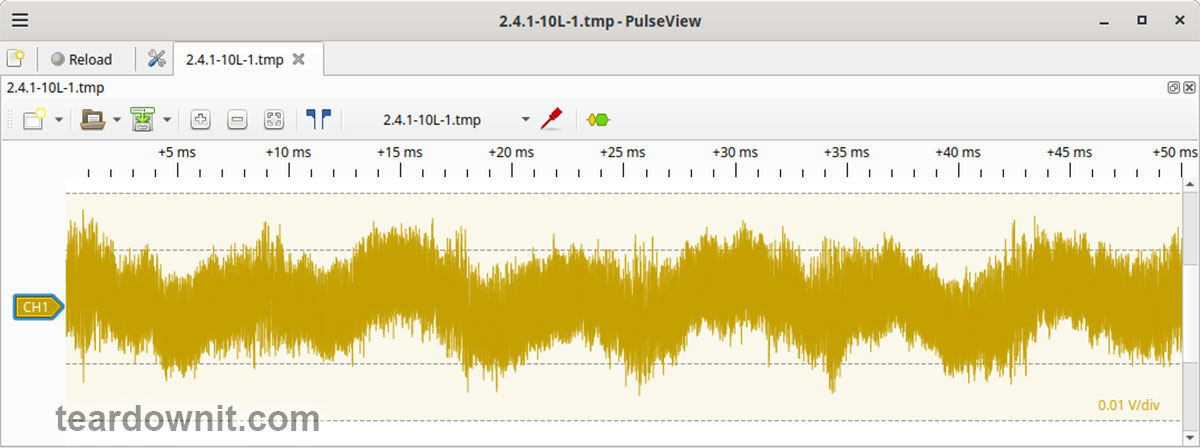Review, teardown, and testing of LRS-75-24 Mean Well power supply
General description

LRS-75-24 is a 24-volt power supply with a maximum current of 3.2 amperes. According to the manufacturer, the unit operates at a mains voltage of 100 to 240 volts without an additional switch. It has no PFC function. The supply measures approximately 4 × 4 × 1 1/5 inches (99 × 97 × 30 millimeters) and is made on a printed circuit board fixed to the base of the metal case. The top cover is perforated, and the holes are meant for passive cooling.

The input and output circuits are connected to a common screw block (1). From right to left, there are 3 terminals for the input line, neutral, and ground wires, and terminals 4 and 5 are the outputs: ground and +24V.
The input voltage goes to the fuse and inrush current limiter (2), then to the RF interference filter (3), and finally, to the diode bridge (4). The inrush current limiter has no markings; apparently, it is just an NTC. The rectified mains voltage is supplied to the 150 uF, 400V capacitor (5) and then to the flyback converter built on an MW03A controller (located on the back side of the PCB), a TK750A60F transistor (6), and a transformer (7).
The voltage from the secondary winding of the transformer is rectified by a Schottky diode HBR20150 (8) and supplied to storage capacitors 2×470uF 35V, and, through an additional LC filter (10) (11), goes to the output.
The feedback circuit is classic; with TL431 (on the other side of the board), the feedback signal is transmitted to the PWM controller through one of the optocouplers (12); the second optocoupler forms a backup channel for overvoltage protection at the OVP output. The installed electrolytic capacitors are designed for operating temperatures up to 220F (105C). The bulkiest of them, the input one, is held on the board with compound.
Build quality is good.
The power transistor (6) and diode (8) are pushed against the metal case using spring brackets to dissipate heat. Their own housings are insulated using special shells.
Test conditions
Most tests are performed using Metering Setup #1 (https://teardownit.com/posts/power-control-unit-for-testing) at 80F (27C), 70% humidity, and 29.8 inHg pressure.
The measurements were performed without preheating the power supply with a short-term load unless mentioned otherwise.
The following values were used to determine the load level:

Output voltage under a constant load

It should be noted that there is a slight overshoot; increasing the load slightly increases the output voltage.
Power-on parameters
Powering on at 100% load
Before testing, the power supply is turned off for at least 5 minutes with a 100% load connected.
The oscillogram of switching to a 100% load is shown below (channel 1 is the output voltage, and channel 2 is the current consumption from the grid):

The picture shows three distinguishable phases of the power-on process:
(Turn On Delay Time) The entire process of entering the operating mode from the moment of powering on is 95 ms.
(Output Voltage Overshoot) The switching process is aperiodic; there is no overshoot.
Powering on at 0% load
The power supply is turned off at least 5 minutes before the test, with a 100% load connected. Then, the load is disconnected, and the power supply is switched on.
The oscillogram of switching to a 0% load is shown below:

The picture shows three distinguishable phases of the power-on process:
(Turn On Delay Time) The entire process of entering the operating mode from the moment the device powers on is 123 ms.
(Output Voltage Overshoot) The switching process is aperiodic; there is no overshoot.
Power-off parameters
The power supply was turned off at 100% load, and the input voltage was nominal at the moment of powering off. The oscillogram of the shutdown process is shown below:

The oscillogram shows two phases of the shutdown process:
(Output Voltage Undershoot) The shutdown process is aperiodic; there is no undershoot.
The amplitude of the current at 100% load before shutting down is approximately 3 A.
Output voltage ripple
100% load
At 100% load, the low-frequency ripple is approximately 20 mV.

At 100% load, the ripple at the converter frequency is approximately 50 mVp-p.

75% load
At 75% load, the low-frequency ripple is approximately 40 mV.

At 75% load, the ripple at the converter frequency is approximately 35 mVp-p.

50% load
At 50% load, the low-frequency ripple is approximately 20 mV.

At 50% load, the ripple at the converter frequency is approximately 40 mVp-p.

10% load
At 10% load, the low-frequency ripple is approximately 10 mV.

At 10% load, the ripple at the converter frequency is approximately 20 mVp-p, and the noise is 80 mVp-p.

0% load
The no-load current consumption measured with a multimeter is 18 mA. The current consumption in this mode is predominantly reactive. In the supply circuit, the input filter contains a 0.47 uF capacitor.
(Power Consumption) It is not possible to measure the exact active power consumption at a 0% load with a basic set of instruments (oscilloscope, multimeter, etc.).
At 0% load, the low-frequency ripple is approximately 10 mV.

At 10% load, ripples at the converter frequency are masked by the 90 mVp-p noise.

Dynamic characteristics
A mode with periodic switching between 50% and 100% load was used to evaluate the dynamic characteristics. The oscillogram of the process is shown below:

The supply’s response to load changes is a bit shaky. The magnitude of the response to load changes reaches 200 mV.
Overload protection
The claimed protection type is "hiccup mode, which recovers automatically after the fault condition is removed." This was confirmed during testing. When a short circuit occurs, the power supply periodically tries to turn back on and, if the overload is still present, turns off again until the next attempt. This operating mode reduces energy losses and heating during overload. Still, it does not allow the parallel connection of multiple power supplies with a common output.
The output current for the overload protection to kick in is 5 A.
Input circuit safety assessment
(Input discharge) Safety assessment is based on the discharge time constant of the input circuits when disconnected from the grid; the value is 0.234 s. This means that when operating on a 120 V input voltage, the time required to discharge the input circuits to safe values (<42 V) will be 0.37 s:

Important: The result is valid for this particular power supply unit; it was obtained for testing purposes and should not be taken as a safety guarantee.

The leakage current at the ground pin is about 11 µA.
Thermal conditions
When operating with no load connected, no component overheating had been noticed.
Thermograms were captured at three power levels: 80, 90, and 100%, fully assembled and with the lid removed. Thermal images show that the most loaded element of the block is the input thermistor (NTC), and its heating seriously stands out against the background of all the other components. At 80% load, it heats up to 197F (92C, 117F above ambient temperature). At 90%, it's 214F (101C, 134F above ambient), and at 100%, it reaches 227F (108C, 147F above ambient).
80% load


90% load


100% load


Conclusions
Overall, the LRS-75-24 is a solid unit. It's noise and ripple are acceptable for many applications, the output voltage is maintained accurately, and the build quality is decent. However, the dynamic characteristics of this power supply are not that good. When load pulses, one can notice large surges and quite some ripple, indicating some circuit design downsides in terms of its frequency characteristics.
For long-term operation, the load should be limited to 80–90% of the nominal one, especially during the hot season when ambient temperatures reach 95F (35C) or more.
Important: The results are valid for this particular power supply unit; they were obtained for testing purposes and should not be used to evaluate all the units of the same type.
.jpg)
.jpg)

Comments
Post a Comment